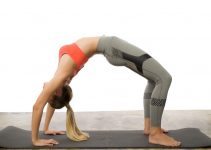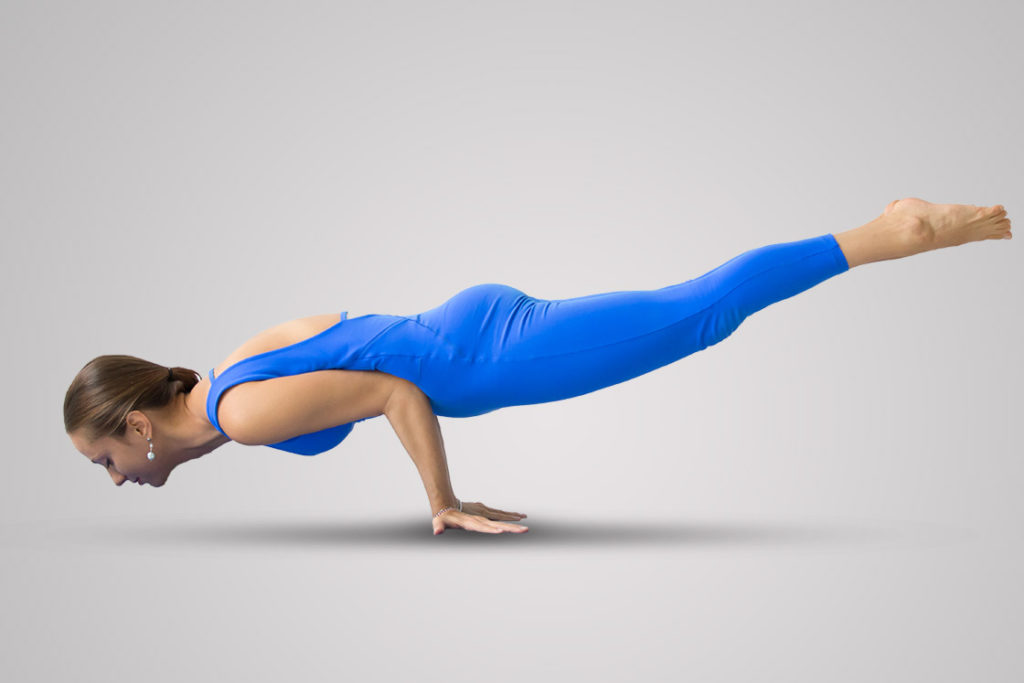
| Sanskrit Pronunciation | Mayurasana (mah my-yur-AHS-anna) |
| Meaning | Mayur = Peacock / asana = pose |
| Pose Type | Arm Balancing and Forward Bending |
| Pose Level | Advanced pose |
| Stretches | Abdominal Muscles, hips, thighs, neck, wrist, palms, forearms, and shoulder, glutes, buttocks |
| Other Names | Peacock Pose, Mayurasana |
Mayurasana, the yoga pose named on peacock, is an advanced level arm balancing pose. Among the 15 asanas of Hatha Yoga, mayurasana is one of the non-seated poses. It’s performed by lifting the body on elbows pressing against the abdomen in the prone position.
Practicing Mayurasana is best considered to benefit the abdominal muscles, shoulder, and back muscles. It also acts as a detoxifier and energy booster for the body. On the mental level, Mayurasana harness attention, and willpower when holding for a longer period.
The upright position in Mayurasana calms the entire nervous system. This further adds to the coordination from various body parts during the practice and affects the whole body physically and psychologically.
Mayurasana Meaning & Significance
In Mayurasana, ‘Mayur‘ means ‘Peacock‘ and ‘Asana‘ means ‘Pose‘. The practitioner’s hands in the final position of this asana look like the feet of a standing peacock and lifted legs seems like feathers of the Peacock. The whole body comes in a dancing peacock-like position in this pose, so it’s called “Peacock Pose”.
In Hinduism, Peacock is associated with Indra, or the ‘God of Thunder and Rain’, who causes rain and nourishes the earth. In this regard, Peacocks are said to be Harbinger ( one who gives an anticipatory sign of what is to come) of rain – by performing a dance to celebrate the arrival of the ‘Rain’.
Importance of Mayurasana
According to B.K.S Iyenger the regular practice of Mayurasana “tones up the abdominal organs wonderfully”, and that the elbow pressure on the abdominal aorta (the artery that carries blood) made blood circulate “properly in the abdominal organs”.
He claimed further that the pose improved digestion, cured stomach and spleen illnesses, and prevented “toxins” from accumulating. He stated also that mayurasana would be of benefit to diabetes.
The Mayurasana is first described in the 10th century Vimanarcanakalpa. In the 1.76-7 verse of Vasistha Samhita, Maayurasana is said to be the destroyer of all the sins. It is also mentioned in one of the ancient books called ‘Hatha Yoga Pradipika‘.
Practice Guide For Mayurasana
This is an easy step by step explanation for the safe practice of Mayurasana.
Contraindications
Prior to the practice of Mayurasana caution should be taken under the conditions like Hernia, Hypertension, Menstruation, and Pregnancy. Practitioners should also avoid practice in abdominal surgery and injuries of the wrist, shoulder, and back.
Preparatory Pose
How to Do Mayurasana (Steps)
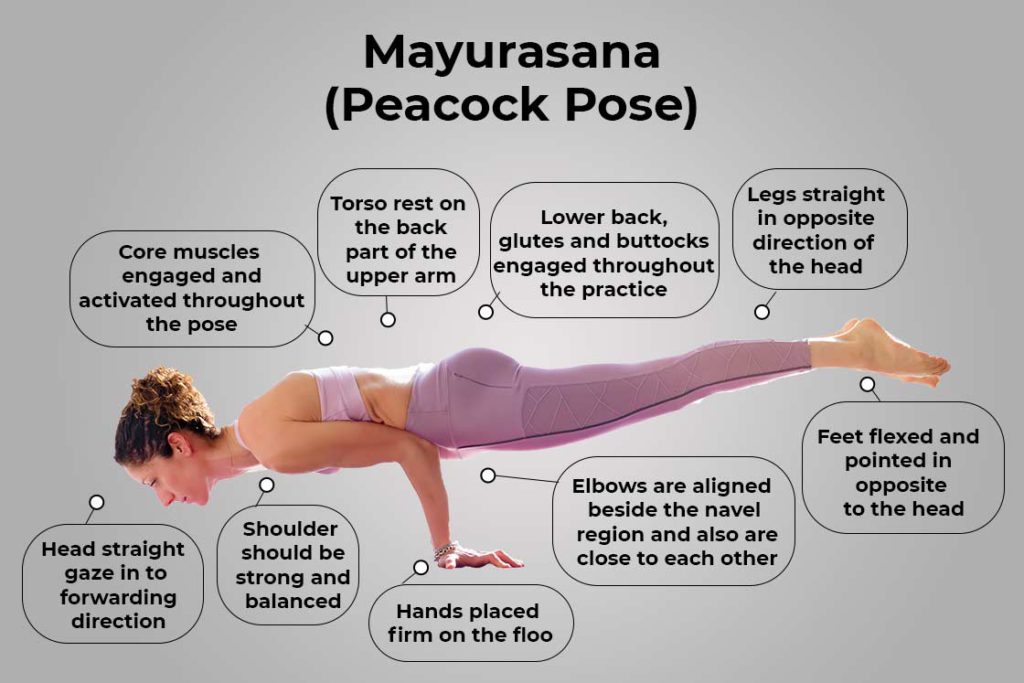
- Begin by coming into Vajrasana and then spread your knees apart to set up a gap in between them.
- Now, lean your shoulder in a forwarding direction to place your palms on the floor just in front of you at some distance. Your fingers pointing your knees.
- After that, firm your palms on the floor along with bending the elbows to rest your torso on the back part of the upper hand. Also, keep your elbows around the navel region.
- As you rest your torso on the upper hand, straight up your legs extending back and balance your body on palms and toes, up to here.
- From here, engage your core to stiff your elbows against it and then lean a bit in a forwarding direction to lift your legs. Flex your neck and gaze right in front of the pose.
- This is the final position of the Mayurasana. Balance here as long as it is comfortable and try to raise your legs up by engaging core muscles.
- Now, release the pose by dropping legs and then knees to the floor. Then, return to the vajrasana by bringing the torso up.
Follow Up Poses
- Adho Mukha Svanasana (Downward-facing Dog Pose)
- Balasana (Child Pose)
- Bhujapidasana (Shoulder Pressing Pose)
Precautions
In order to avoid some common mistakes, these precautions should be keep in mind while performing mayurasana;
- Practitioners should perform a short stretch before bending the elbows to activate the torso muscles. This will prevent the chances of muscular injury as one leans into the posture.
- One should avoid lifting legs with a jerk while going into the final position of Mayurasana. It might result in falling by face on the floor, so, keeps slow and steady while leaning into the final pose.
- Elbows need to be together or should be close to each other in order to get grip on the engaged core muscles. Otherwise, swaying elbows disbalance the torso from its position.
Mayurasana Beginners Tips
- Holding your body in Mayurasana engages puts triceps brachii muscles in eccentric contraction. It needs immense strength in the forearms and shoulder. So, beginners with no history of asana practice should work on strengthening the tricep [efn_note] Tricep Exercises to Build Muscle https://www.menshealth.com/uk/building-muscle/a759179/tricep-exercises-best-build-muscle/ [/efn_note] before going into the peacock pose.
- A practitioner with belly fat and weak abdominal muscles might face difficulty in engaging core muscles for mayurasana. Therefore, one should reduce belly fat or strengthen core muscle to begin the Mayurasana practice.
- This asana is a challenging one and the experience of pain while the practice is common if you are not enough skilled. So, beginners should return immediately to the Vajrasana in such a situation.
Props and Modifications
To ease the mayurasana for beginners, one can always use the modified version of the pose by the use of props. Here are some ways to use props to modify mayurasana;
- To avoid swaying of the elbows in the final position of Mayurasana practitioners can wrap a strap around their elbows. This further invigorates the foundation of the pose.
- In case of difficulty to keep legs lifted during the final pose, practitioners can use chair support under their feet. They can also take help from another person to find a balance in the pose.
- Practitioners can place blocks under their palms. This gives a slight raise to the pose, which keeps it in balance for a longer period.
Variations
The Padma Mayurasana and Pungu Mayurasana Padmasana are advanced variations of Mayurasana. The practitioners who want to raise the level of challenge in their practice can go through these variations below;
1. Padma Mayurasana (Lotus in peacock pose)
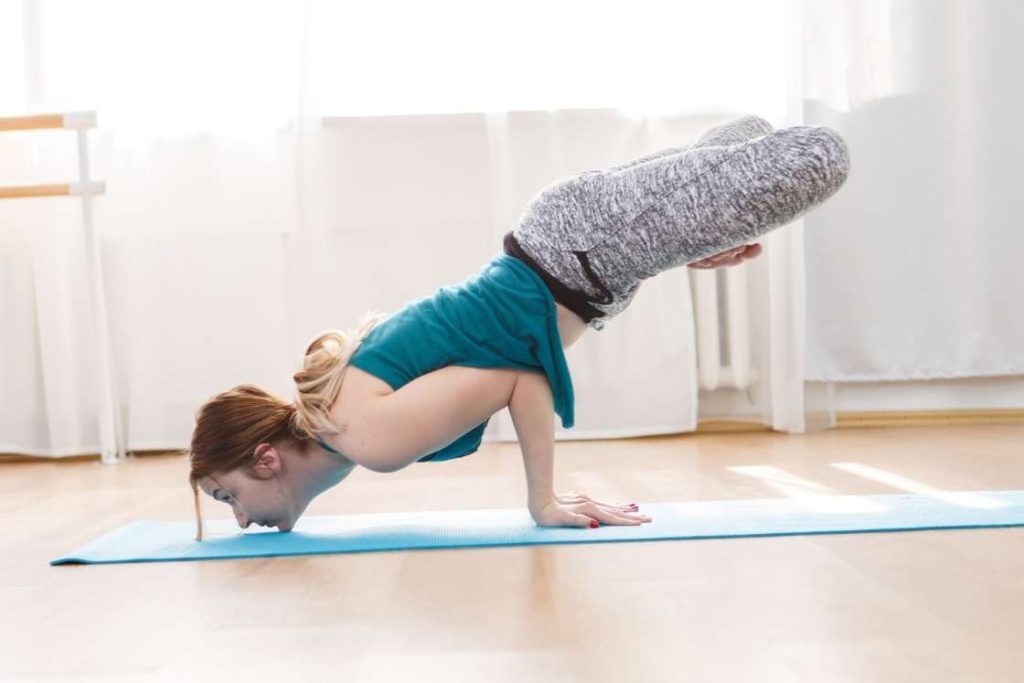
In Mayurasana, the legs remain straight and are flexed along with toes pointing in the back direction. Whereas in Padma Mayurasana, the legs are folded in Padmasana and are supported by the core muscles along with glutes and thighs engagement.
In Padma Mayurasana, the legs are folded to form a Padmasana. The entire body weight is supported over the hands, while the core muscles and squeezed thighs are supporting the folded legs in Padmasana.
2. Pungu Mayurasana (Wounded Peacock Pose)
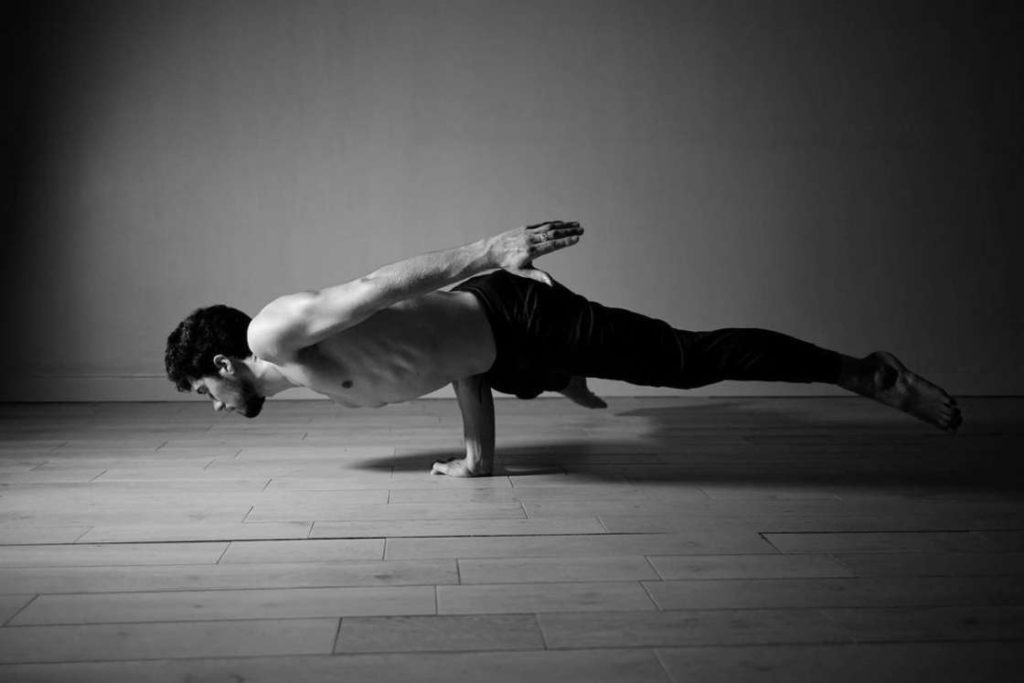
Here, the body is supported by either hand whose elbow is tucked beside the navel region. The feet remain straight and balanced by core muscles and another hand stays in the air. Whereas, In Mayurasana, feet remain straight and elbows placed around the navel against the core muscles.
The Pungu Mayurasana is another variation for the Mayurasana. Here, the body is rest upon a single hand where the elbow rest beside the naval area. The feet remain straight and another hand remains in the air in the forwarding direction.
Mayurasana Benefits
The pressure created by elbows in Mayurasana may stimulate the vagus nerve. Different benefits of Mayurasana including the calming effect on the brain, detoxification, and enhanced digestion comes from its ability to stimulate the vagus nerve.
Therapeutic Benefits
- In a study paper Anatomical Explanation of “Mayurasana” [efn_note] Anatomical Explanation of “Mayurasana” https://www.ijtsrd.com/papers/ijtsrd29884.pdf [/efn_note], it’s explained, elbows on the abdomen massages digestive organs. This ensures toning digestive organs and also improves functioning. Hence, mayurasana overcome digestive ailments like indigestion, constipation, and bloating.
- The Mayurasana stimulates the Pancrease gland to secrete insulin hormone, which regulates blood glucose levels in the blood. This in turn act as a therapeutic aid to Diabetes and hyperglycemia in middle-aged patients [efn_note] Role of yoga in control of hyperglycemia in middle aged patients of non-insulin dependent diabetes mellitus https://link.springer.com/article/10.1007%2FBF02871003 [/efn_note].
1. Improve Agility and Flexibility
Practicing Mayurasana affects the brain’s region like the cerebellum and Frontal lobe. These regions are responsible for fine motor movement, balance, and the brain’s ability to determine limb position. According to one studies [efn_note] EFFECTS OF SELECTED ASANAS IN HATHA YOGA ON
AGILITY AND FLEXIBILITY LEVEL http://journalshr.com/papers/Vol%201_N%202/V01_2_2.pdf [/efn_note], regular practice of Mayurasana showed significantly
improvement in agility and flexibility level.
2. Strengthens Reproductive System
To keep the mayurasana posture balanced, muscular contraction takes place in this pose. This contraction massages and tones up the reproductive system. This nourishes the organs and vitalizes them to function on an optimum level in males and females.
3. Helps in Detoxification
According to one of the Research [efn_note] A review of asanas referenced in ancient texts and a brief comparative study of selected asanas https://www.anantaajournal.com/archives/2019/vol5issue4/PartE/5-4-48-526.pdf [/efn_note] Mayurasana is an intensive yogic pose that enhances the body’s metabolism in some time while being in the pose. This flushes out more CO2 from the lungs and cleanses the skin as we sweat in the asana. It also raises blood flow promoting better circulation to pump white blood cells through the body and help organs cleanse themselves effectively.
4. Strengthens Musculoskeletal System
The advanced level of this asana makes it challenging enough that with regular practice it can totally transform the practitioner body. The stress bear by the muscles and bones while practicing Mayurasana makes them stronger and tougher. Hence, strengthens the overall musculoskeletal structure.
5. Helpful in Annavaha Srotas (Gastro Intestinal Tract)
Manipur Chakra has control over several functions of the digestive system which is even affected by psychosomatic disorders [efn_note] Psychosomatic Disorders https://patient.info/mental-health/psychosomatic-disorders [/efn_note]. It is associated with the power of fire and digestion which become stimulated on the regular practice of Mayurasana. Hence, helpful in Annavaha Srotas or Gastro-Intestinal Tract.
Mayurasana practice is helpful in regulating the functions of Manipura Chakra which indirectly influences Annavaha Srotas [efn_note] Influence of Manipur Chakra (Coeliac Plexus) on Annavaha Srotas (Gastro-Intestinal Tract) https://www.tmjournal.org/?mno=278120 [/efn_note].
6. Soothes Nervous System
The regular practice of Mayurasana activates the Sympathetic Nervous system. Activation of which has several knock-on effects, one of which affects the vagus nerve. The vagus nerve serves an important function because it has a direct impact on our parasympathetic nervous system, which helps us feel calm. Hence, soothes the entire nervous system.
Conclusion
Mayurasana is a challenging but effective asana that tones up abdominal organs, stimulates the digestive system, and strengthens the reproductive system. Hence, it is an overall health and wellness gift in the form of the yogic pose in today’s world.
By regular practice, one can achieve mastery in this pose and can get various benefits associated with it.


